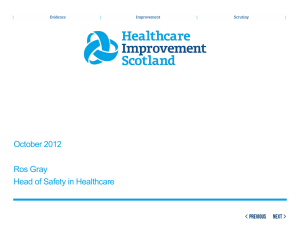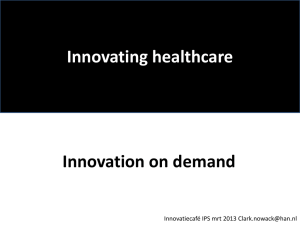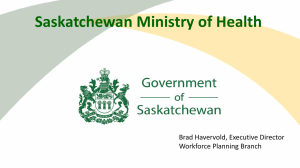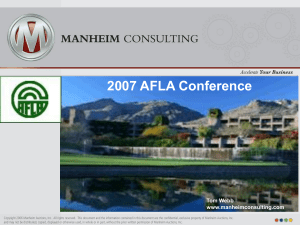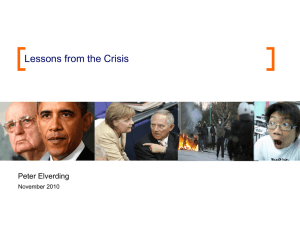Safe Care - NHS Ayrshire and Arran.
advertisement
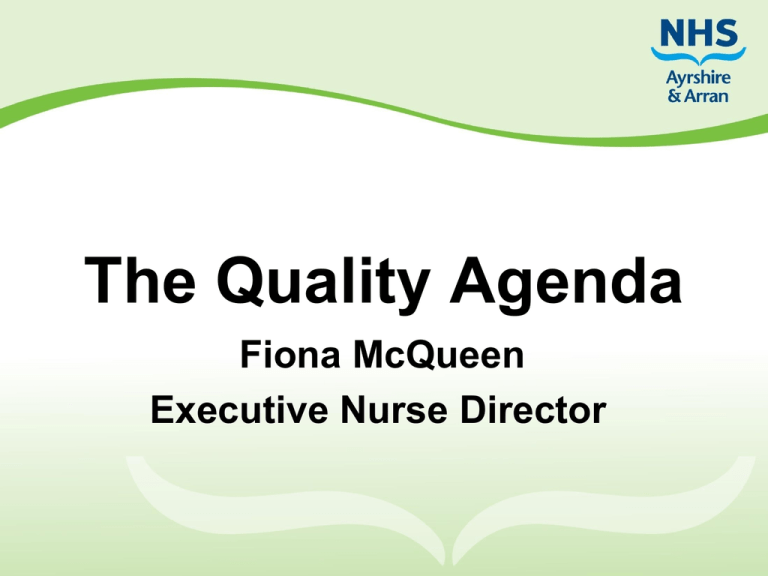
The Quality Agenda Fiona McQueen Executive Nurse Director What is world class healthcare? Where are we now? Where do we want to be • 2 years • 5 years • 20 years Call to action for the journey Cabinet Secretary NHSScotland Healthcare Quality Strategy At its heart is a simple but very ambitious aim: “To make the NHS in Scotland a world leader in the quality of health care services that it delivers.” “That aim is not just good for patients, it is also right for staff.” Scottish Parliament, Debate 13 May 2010 Quality Strategy built on people’s priorities •Caring and Compassionate health services •Collaborating with patients and everyone working for and with NHSScotland •providing a Clean and safe care environment •improved access and Continuity of care •Confidence and trust in healthcare services •delivering Clinical excellence • Person-Centred - Mutually beneficial partnerships between patients, their families, and those delivering healthcare services which respect individual needs and values, and which demonstrate compassion, continuity, clear communication, and shared decision making. • Effective - The most appropriate treatments, interventions, support, and services will be provided at the right time to everyone who will benefit, and wasteful or harmful variation will be eradicated. • Safe - There will be no avoidable injury or harm to patients from healthcare they receive, and an appropriate clean and safe environment will be provided for the delivery of healthcare services at all times. Safe Quality Effective Person Centred Quality occurs more frequently when the three ambitions are delivered together Aim Everyone gets the best start in life and is able to live a longer healthier life at home or in the community . Healthcare is safe for every person every time and every experience of healthcare will be positive, delivered by staff who feel supported and engaged. Primary Driver Secondary Driver The Care Experience of patients and their families is improved •Leadership – executive leaders demonstrate that everything in the culture is patient focused •Nothing about me without me •Healthcare systems deliver reliable, quality care •The care team installs confidence by providing collaborative, evidence based care •Patients get the outcomes of care they expect All services are coproduced •Partnership working with communities served as equal partners •Asset based service redesign •Services reflect an asset based approach (placebased, relationship-based, citizen-led and promote social justice/equality) •Outcomes based commissioning There are no needless deaths There is no needless harm Staff experience and well being is improved •Hospital Standardised Mortality Ratio are best in class for Scotland •Clinicians review all unexpected deaths as a matter of routine and continuously learn and make improvement •No patient is subjected to needles harm due to unreliable systems and or processes •Any episode of harm is reviewed as a matter of routine and continuously learn and make improvements •Staff are recruited for values •Staff governance standards are adhered to consistently •An asset based approach to staff well-being is taken •Compassionate communication and teamwork are essential competencies •‘One set of rules’ for all •Community benefit in all employee contracts World Class Healthcare •The people of Ayrshire and Arran have the best possible start and live longer healthier lives in settings of their choice whenever possible. •Care is co-produced to deliver no needless waits •There are no needless deaths •There is no needless harm •Every experience of Healthcare is positive •All staff who deliver healthcare feel supported engaged and valued Do you agree? •Take 10 minutes to discuss at your tables •Is this what world class healthcare looks like? Tell us what is missing High performing organisations • Culture and leadership focus – high value organisations define and relentlessly and consistently demonstrates values • Specification and planning: high-value organisations base operational and core clinical decisions on explicit criteria and organise effectively • Infrastructure design: High-value organisations create highly effective teams at the micro level, to meet the needs of patient and families. High performing organisations • Measurement and oversight: High-value organisations use measurements of clinical operations for internal process monitoring to drive improvement. • Staff focus - high value organisations ensure staff involvement and ownership • The learning organisation: high value organisations examine positive and negative deviations in care and outcomes, using the information create common tools to improve outcomes. How will we get there? Culture Your culture is an outcome of the way employees behave. So how are we encouraging our employees to behave? Lived values = positive behaviours Relentless modelling of positive behaviours delivers positive attitudes. Current values •Team work •Efficiency •Equality •Excellence •Care •Improvement What behaviours are required to build a culture of excellence? Select your top five behaviours from the cards at your table. As a board what is your role in the delivery of ‘lived’ values to improve culture ? What’s in a Wordle? Insert wordle What’s in a Wordle? Does this Wordle capture our ambitions? How should we promote these behaviours? What should be the consequence for those who don’t adhere to them? What we think we “know” •Better quality costs more money •If you want to ― get “Safe Care” it will cost MUCH more money Now here is the “truth” • Good quality care costs LESS than poor quality care • Safe, harm-free care SAVES Money. It costs less to provide, and avoids costs of correction. Learning from the Henry Ford Health System So, where to focus our efforts? ? Safe care Harm Free Care Unsafe care Where are we now? Safe, Effective and Person Centred •Leadership •Critical Care •General Ward •Peri-operative •Medicines Management Maternity Mental Health Primary Care Sepsis VTE collaborative Outcome aims • Mortality: 15% reduction • Adverse Events: 30% reduction • Ventilator Associated Pneumonia: 0 or 300 days between • Central Line Bloodstream Infection: 0 or 300 days between • Blood Sugars w/in Range (ITU/HDU): 80% or > w/in range • MRSA Bloodstream Infection: 30% reduction • Crash Calls: 30% reduction Hospital Standardised Mortality Rates (all patients) -2007/08 6 A 5 B Z 4 P Rate(%) H C F 3 G E K L I O X N Q T U Y S M AA W V AC AB R 2 J D 1 0 0 5,000 10,000 15,000 20,000 25,000 Number of Patients 30,000 35,000 40,000 45,000 “When something goes wrong it is how the organisation acts that redefines and reshapes the culture.” Jeanette Clough, President & Chief Executive Officer Mount Auburn Hospital, Boston, MA, USA What did we find? Failures Clinical Observation •Identification of sick patients Need for Palliative and End of Life Care •Planning and execution of care and treatment •Rescue of deteriorating patients Unreliable and Variable Care Variation in Record Keeping Coding Clinical Escalation DNA CPR Failure to Rescue Infection and Falls Scotland HSMR – 9.3% reduction Standardised Mortality Ratio (SMR) Regression line Standardised Mortality Ratio 1.5 1.0 0.5 Oct- Jan- Apr- Jul- Oct- Jan- Apr- Jul- Oct- Jan- Apr- Jul- Oct- Jan- Apr- Jul- Oct- Jan- Apr- JulDec Mar Jun Sep Dec Mar Jun Sep Dec Mar Jun Sep Dec Mar Jun Sep Dec Mar Jun Sep 2006 2007 2007 2007 2007 2008 2008 2008 2008 2009 2009 2009 2009 2010 2010 2010 2010 2011p 2011p 2011p Ayr – 9.8% reduction Crosshouse - 27% reduction Improvement methodology SPSP tools and methods to support implementation of improved practices Plan-Do-Study–Act (PDSA) cycles to develop improvements in clinical practice Engaging all staff to ensure ownership of new ways of working Involvement Teams must own the processes to achieve improvement Teams Improvement Experts Spread Plan, do, study, act Improvement Sustain Ayr Hospital General ward spread Back to Basics programme spread across Crosshouse. completed in all in-patient areas. All wards monitoring and measuring MEWS, Safety Brief and SBAR plus all other GW measures Improvement programme spreading at Ayr – 6 wards complete and monitoring and measuring compliance with all BTB /General Ward measures. Spread to continue through to March 2013 Ja n08 Ap r- 0 8 Ju l-0 8 O ct -0 8 Ja n09 Ap r- 0 9 Ju l-0 9 O ct -0 9 Ja n10 Ap r- 1 0 Ju l-1 0 O ct -1 0 Ja n11 Ap r- 1 1 Ju l-1 1 O ct -1 1 Scottish VAP rate (per thousand ventilator days) 20 18 16 14 12 10 8 6 4 2 0 61% reduction 9.11 3.54 Ja n08 Ap r- 0 8 Ju l-0 8 O ct -0 8 Ja n09 Ap r- 0 9 Ju l-0 9 O ct -0 9 Ja n10 Ap r- 1 0 Ju l-1 0 O ct -1 0 Ja n11 Ap r- 1 1 Ju l-1 1 O ct -1 1 Percentage compliance with surgical briefing 100 95 90 85 80 75 70 65 60 55 50 94% 20% improvement 74% Spread of work in theatres Percent of patients who have peri-operative briefing. Excellent compliance across all theatres in surgical pause and briefing prior to surgery Person centred – some examples of the good • 92% of in-patients said they were treated with dignity and respect (2011 n=3600) • 90% of patients rate the overall care experience received from their GP Surgery as positive (2012 n=8672) • Patients rate the quality of consultation with many doctors, nurses and AHP’s highly (CARE measure mean score 45/50 – mean score normative data 43/50) Person centred – some examples of the not so good • 40% of all the formal complaints are customer service related (i.e. communication, attitude, courtesy, respect) • Overall customer service satisfaction rating to be 56.3% positive (2011 n= 752 staff and patients) • 47% of patients were not told how long they would have to wait in A&E (2011 n=3600) • 22% of patients were unable to book a GP appointment 3 or more days in advance (2012 n=8672) Immediate interventions to support improvements in Patient Centred Care • Quality of Consultation - Use of the CARE measure • Customer Care Commitments • Caring Behaviours Assurance System (CBAS) • ‘Teach back’ approach to improving communication with patients • Better Together Programme • Improving Patient and family involvement in care • Developing volunteer opportunities • Developing Co-production approaches The stories behind the data Andy As a Board Member, do you know the names of the people who have been harmed or killed in your hospitals and healthcare systems because of unsafe, unreliable systems ? As a Board Member, do you know how many clinicians have been damaged as a result of unreliable or unsafe systems and processes of care? What approach would you want the Board to take if it was your mother, father, partner, child ? What assurance does the Board need that we are providing world class health services and that we are learning from events. Discuss at your table and agree the top 2 things that would provide you with assurance Ah … but! • Safety improvement excellent in pilot sites • Person centred care excellent in some areas • Spread taking for all taking longer than we need to drive improvement • New commitment to - 20% reduction in Mortality - 95% patients receive harm free care - Improved person centred care • Capacity and capability building is required to enable change and improvement Capability and capacity • Capability – the people have the confidence and the knowledge and skills to lead the change. • Capacity – having the right number and level of people who are actively engaged and able to take action. Helen Bevan, Journal of Research Nursing 2010; 15: 139-148 Take 10 minutes at your table to discuss … How the organisation can build the capacity and capability necessary to drive quality improvement at pace and scale What skills are needed? Many People Few People Change agents All staff Shared Knowledge Middle Operational Manager Leaders Level Experts A key operating assumption of building capacity is that different groups of people will have different levels of need for Improvement knowledge and skill. Our approach will be to make sure that each group receives the knowledge and skill sets they need when they need them and in the appropriate amounts Deep Knowledge Continuum of Improvement Knowledge and Skills What do we have currently? QI capacity and capability 45 40 35 30 25 20 15 10 5 0 change agents QI Leaders Experts What next? Take five minutes at your table to discuss as a Board Member what you will personally do to drive or promote the Quality Agenda
